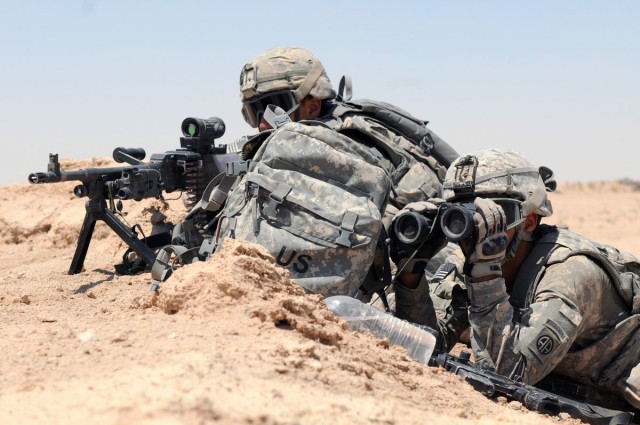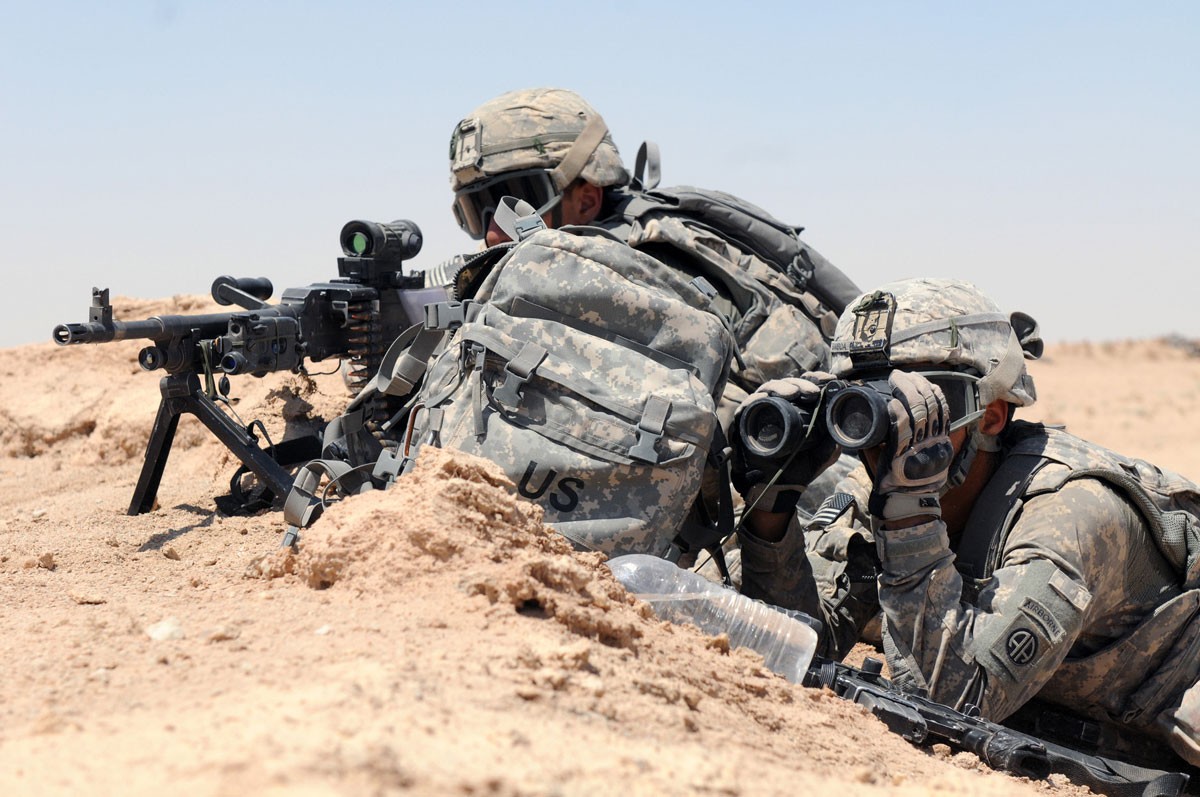BAGHDAD, Iraq - The U.S. Army's 1st Advise and Assist Brigade recently joined forces with Iraqi commandos of the 7th Iraqi Army Division for an air assault operation in search of a possible IED production facility outside the town of Rawah.
"Five minutes!"
Aboard four different aircraft, the U.S. and Iraqi Soldiers, following standard procedure, held up five fingers as each one repeated the time warning to the next one, mentally preparing for what was about to occur.
"One minute!"
A single finger went up, and the Soldiers prepared to rush out of the doors of the helicopter. Expressions were serious as the ground grew closer and safety harnesses holding the passengers in place were released. The rotor of the aircraft churned up a giant cloud of dust.
One by one, the joint force exited the doors and laid down, just steps away from the aircraft. There they waited, in the prone position, keeping eyes open for possible hostile threats. As the helicopter lifted off, a vast and arid desert landscape opened up before the Soldiers.
Because of an increased usage of improvised explosive devices in the area of Rawah, Iraqi Army forces conducted the mission with the assistance of U.S. forces.
The Iraqis led the assault with Company B, 1st Battalion, 504th Parachute Infantry Regiment, 82nd Airborne Division Soldiers providing cover and support if needed, said Capt. Christopher Gemmer, company commander.
However, before the mission could start, there was much planning and training to be accomplished, consisting of long days of practice and preparation spread over several weeks, with members of the company's 2nd platoon assisting and coordinating the training of the Iraqi Army soldiers.
"They are eager to learn," said Staff Sgt. Robert Burnett, weapons squad leader and a Pickens County, S.C., native, assigned to Company B. "It's like getting new [soldiers], although they have a lot of knowledge, so we share information. It's nice to see other forces' tactics and how effective they are."
Through several drills, including entering and exiting different types of helicopters, movement over urban terrain and room clearing techniques, the Iraqi Army soldiers acquired a new set of skills.
"Operating around any type of aircraft is generally safe, but with all the excitement, it could be dangerous," said Sgt. 1st Class Gary Wilson, a Baltimore native, also assigned to Company B. "With room clearing, target identification is key. They have to make sure occupants are unarmed or armed, or if they are a threat."
Wilson also said maintaining this kind of discipline will help build trust with the people of Iraq.
Armed with this new-found knowledge, the joint forces set out to search the area outside of Rawah.
As helicopters dropped the Soldiers at a location outside the village, the U.S. Soldiers moved quickly to a sand dune to provide cover for the Iraqi force, which maneuvered throughout the buildings.
The intense heat beat down on the Soldiers as scout helicopters buzzed overhead like angry wasps. As the Iraqi soldiers moved from one building to the next, the U.S. Soldiers shifted their aim to the next predetermined location. One by one, the structures were cleared and the sectors of fire adjusted.
As the Iraqis completed the mission and moved back in an orderly formation to the link-up point, they re-established security with their U.S. counterparts.
"We are here to help them, to work side-by-side," said Spc. Christopher Brown, rifleman assigned to Company B. "Joint operations are about showing them the way to be successful."
Together, the two forces returned to the landing zone and a predetermined signal was given for pickup.
Soon, the aircraft landed, once again stirring up a miniature sand storm. The Soldiers, already in proper load order, ran to the open doors, loaded the aircraft and strapped themselves in. A quick check of the assembled team was completed and the thumbs-up was given to the helicopter crew and with a roar, the Black Hawks rose into the blue sky and returned to Camp Khalid.
Though no evidence of a facility capable of manufacturing explosives was found, leaders listed at least two factors that made the mission a success: First, not a single Soldier was injured during the mission; second, the Soldiers of two separate countries were able to effectively work together.
"The 82nd Airborne has gone above and beyond to ensure our Iraqi counterparts are ready to take over security for their country after we leave," said 1st Lt. Theron Tingstad, a platoon leader for Company B, and a Detroit native. "We hope it grows - that this battalion can get the job done - no matter what it regards."




Social Sharing